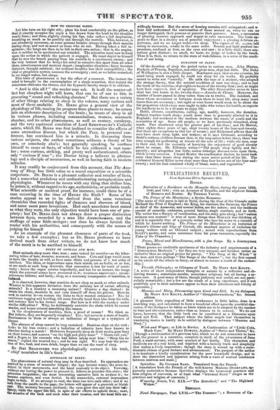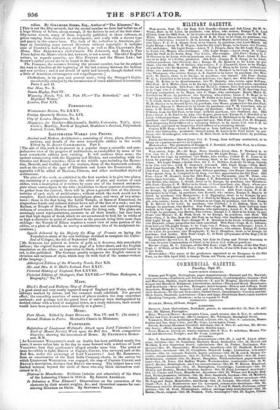PUBLICATIONS RECEIVED, From September 224 to September 29 th.
BooKs.
Narrative of a Residence on the Mosquito Shore, during the years 1839, 1840, and 1841' with an Account of Truxillo, and the adjacent Islands of Bonacca and Roatan. By Thostes YOUNG.
The Prince of the Mountains; a Syrian Romance.
[The scene of this poem is laid in Syria, during the time of the Crusade under Richard the First of England ; the King, his warriors, the Saracens, the Prince or chief of the Assassins, and several ladies, are the actors ; and the incidents consist of councils, embassies, general battles, single combats, and so forth. The writer has a fluency of versification, and his story gets along; but" cielum animam non mutant" is true of more things than HORACE was thinking of, and it is especially true of a juvenile writer who lays his scene in a country of which he knows nothing. The Prince of the Mountains is an imitation of BYRON'S Giaour and Siege of Corinth, the standard sources of imitation for young writers with an Oriental subject ; mixed with reproductions from SCOTT'S poetry, and some assistance from his prose romances, especially the Tales of the Crusaders.] Poems, Moral and Miscellaneous, with a few Songs. By a Journeyman Mechanic.
[These poems are creditable specimens of the industry and acquirements of a " Journeyman Mechanic "; but they are very unequal, and betoken rather an imitative than an original genius for poetry. "The Song of the Winds" is the best, and then perhaps "The Songs of the Seasons "; but the first-named so far excels all the others in fancy, as almost to induce a doubt of the author- ship.]
Fireside Philosophy; or Glimpses of Truth. By MARY ANN KELTY. [A series of short independent thoughts or axioms by a reflective and ob- serving woman ; sometimes secular, sometimes religious, but all having a se- rious cast. A good many of them, though judicious and useful, are not parti- cularly remarkable ; but a few are the result of a long experience, and if not positively new in their substance appear so from their directness and felicity of expression.] Mamma and Mary, Discoursing Tien Good and Evil. In six dialogues. By MARY ANN KELTY, Author of" Straightforwardness," 8r.e. Second edition.
t little exposition of little weaknesses in little ladies, done in a searching way, and calculated to have a beneficial effect upon the youthful cha- racter, if the dialogues be taken as hints which are to be adapted by the teacher to time and circumstances, rather than as lessons to be conned. We do not know, however, that the little book can be considered as a Discourse upon Good and Evil. That subject where the fallen angels lost themselves in wandering mazes is hardly to be settled by dialogues between "Mamma and Mary."]
Work and Wages; or Life in Service. A Continuation of "Little Coin, Much Care.' By MARY BOWITT, Author of" Strive and Thrive," &c. [Though a continuation of a previous talc, which we do not remember to have read, the present is a narrative, complete in itself, of the adventures of Jane Ford, a maid-servant, with some account of her family. The characters and incidents are of a real kind, and depicted with • homely truth and simplicity that makes a lively impression; though the story is wound up with a melo- dramatic climax of good fortune and advancement. The purpose of the author is to inculcate a kindly consideration for the poor household drudge, and to show the discomfort and injustice arising from a want of mutual confidence between mistress and maid.]
Spirit/ion. By GEORGE SAND. Translated from the French. [A translation from the French of the well-known Madame DUDEVANT, ap- parently undertaken because Spiridion displays the tyrannical practices and false religion of convents, or at least what " Getman SAND" alleges as the practices and religion of convents.]
Waverley Novels, Vol. XIX.—" The Betrothed," and "The Highland Widow."
SERIALS.
Novel Newspaper, Part LVII.—" The Yeinassee "; a Romance of Ca-
saline. By GILLYORE Smuts, Esq., Author of" The Kinsman," &c. [This is not the fifty-seventh, but the second number we have had before us, of a large library of fiction, cheap enough, if the fictions be not of the first class: fifty-seven novels, many of them originally published in three volumes, at prices varying from sixpence to sixteenpence, and really with a decent type and paper, in the octavo form. The bulk of the collection is American, per- haps as furnishing more current literature without copyright : it includes nine of COOPER'S, half- a-dozen of BIRD'S, as well as Mrs. CLATERS'S New Home, Miss SEDGWICK's chef-Xceuvre The Linwoods, and DANA'S Two
Years before the Mast-which last, however, is not a novel. The chief English writers, as regards quantity, are Miss PoRTER and the Misses LEE; but ScoTT's earlier poems are to be found in the list. The Yemassee, the romance forming the present number, has for its subject the wars in Carolina at the beginning of the last century between the Indians and new settlers ; and is not devoid of spirit and interest, though dashed with a little of American extravagance and magniloquence.]
Cheltenham, in its past and present state ; being the Stranger's Guide, considerably enlarged by the introduction of much additional information. Parts I. and H.
Our Mess, No. X.
Susan Hopley, Part IV.
Waverley Novels, Vol. IV. Part IV.-" The Betrothed," and "The Highland Widow."
London, Part XIX. PERIODICALS.
Westminster Review, No. LXXV. Foreign Quarterly Review, No. MX. City of London Magazine, No. L Magazines for October-Blackwood's, Dublin University, Tait's, Ains- worth's, Monthly, North of England, Bradshaw's Journal, Polytechnic Journal, Union, Mirror.
ILLUSTRATED WORKS AND PRINTS.
Ancient and Modern Architecture ; consisting of views, plans, elevations, sections, and details of the most remarkable edifices in the world. Edited by M. JULES GAILHABAUD. Part I. [The aim of this work is to present in a popular shape a scientific and com- prehensive view of the progress of architecture, as exemplified by some of the most remarkable edifices now existing. It will embrace three seats; the ancient commencing with the Egyptian and ilindoo, and concluding with the Grecian and Roman remains; those of the middle ages including the Byzan- tine, Moorish, and Gothic; and the modern, those of the fourteenth century, such as the styles of the ages of Elizabeth and Louis the Fourteenth. An appendix will be added of Mexican, Chinese, and other unclassified styles of architecture.
The plan of the work, as exhibited in the first number, is to give two plates, one consisting of a perspective view, the other of plan and section of each edifice, with a description of it written by some one of the learned archreolo- gists whose names figure in the title : in addition to these separate descriptions, we gather from the context, there will be given a general view of the charac- teristics of each style of architecture; without which the work would not be complete. Each number contains descriptions, plans, and views of two struc- tures: those in the first being the Little Temple, or Speos of Ebeamboul, its stupendous façade and colossal statues hewn out of the face of a rock ; and the Kaden, or Temple of Siva, at Ellora, of vast size and extent and surpassing richness of ornament, likewise excavated from the living rock. The plates are seemingly exact representations, accurate in all their details ; but they have not that high degree of finish which we are accustomed to look for in works of so high a character in point of excellence as the present, being little more than etchings: the Temple of Ellora requires a nearer view of some portion of the edifice, or a plate of details, to convey a satisfactory idea of its sculptured de- corations.] Speech delivered by his Majesty the King of Prussia on laying the Foundation-stone of the new buildings destined to complete the Cathe- dral of Cologne, the 4th of September 1842. [Mr. Scnr.oss has printed in letters of gold, as it deserves, this remarkable address; the original German on one page of a letter-sheet, and the English translation on the other : an impression in black, with an ornamental border in red, is also published. The German greatly surpasses the English version in elevation and raciness of style, which may vie with that of the muter-writers of the language.] Abbotsford Edition of the Waverley Novels, Part XIL Mr. and Mrs. S. C'. Hall's Ireland, Part XXIV.
Pictorial History of England, Part LXVIII.
Pictorial Edition of Shakopere, Part XLVIII.-" William Shaksperc, a Biography," No. IV.
Mars.
Black's Road and Railway Mop of England.
[A good-sized and very neatly engraved map of England and Wales, with the railways marked by colour, and the common roads exhibited. For general effect, the exceeding numbers of names of places renders the map somewhat confused ; and perhaps bad the grand lines of railway been distinguished by decided colour with a kind of marginal index, as a ready reference, their course would have been perceived more distinctly at a glance.]
Music.
Part Music. Edited by JOHN HoLuan. Nos. IV. and V. (In score.) Second Medium in Parvo. Merriott's Chants in Miniature.
PAMPHLETS.
Refutation of Lieutenant Wellsted's Attack upon Lord Valentia's (now .Earl of Mount Norris) Work upon the Red Sea. With comparative diagrams, showing the inventions of Bruce. By FREDERICK ROBIN- SON, R.N.
[As Lieutenant WELLSTED'S work on Arabia has been published nearly five y_ears, it seems rather late in the day to come forward with a defence of Lord VALLETTA from that gentleman's alleged attacks upon him. The point at issue is-which is right, Bailee or Captain Comm, who surveyed part of the Bed Sea, under the patronage of Lord Vateseria ? And Mr. Rointsmox, from an examination of the East India Company charts, in the survey for which Lieutenant WELLSTED was engaged, the map of Captain COURT, and Bouce's description, declares that BRUCE Was wrong. The subject bass very limited interest, beyond the circle of those who may think themselves con- cerned in it.] .Distress in Manchester. Evidence (tabular and otherwise) of the State of the Labouring Classes in 1840-2. By JOSEPH ADSHEAD.
I. Selenium a True Element? Observations on the connexion of the elements by their atomic weights, &c., and theoretical reasons for con- sidering Selenium an Oxide. By Smueus PIESSE,



























 Previous page
Previous page